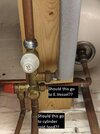I have a Vaillant system boiler and Vaillant hot water cylinder, when someone runs a tap anywhere in the house the shower changes temperature and the pressure drops. I am wondering if this is due to the location of the pressure reducing valve.
The mains water goes straight to the PRV, from there it splits to the boiler and also back to the rest of the house to feed everything else including toilets, sinks etc. Should everything in the house be at this reduced pressure or should only the boiler be at this lower pressure?
Thanks.
The mains water goes straight to the PRV, from there it splits to the boiler and also back to the rest of the house to feed everything else including toilets, sinks etc. Should everything in the house be at this reduced pressure or should only the boiler be at this lower pressure?
Thanks.




